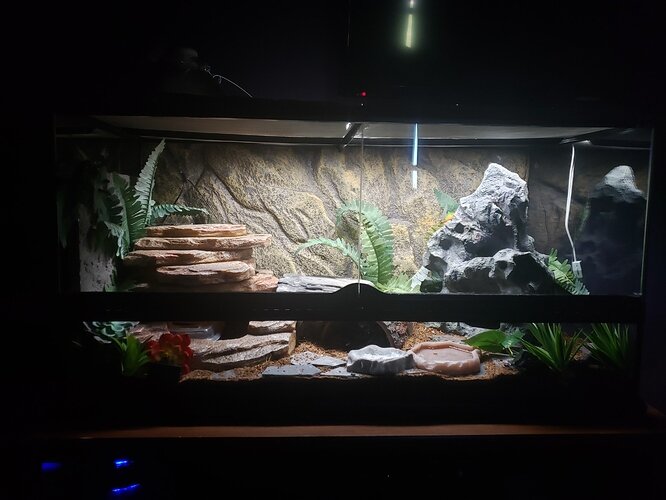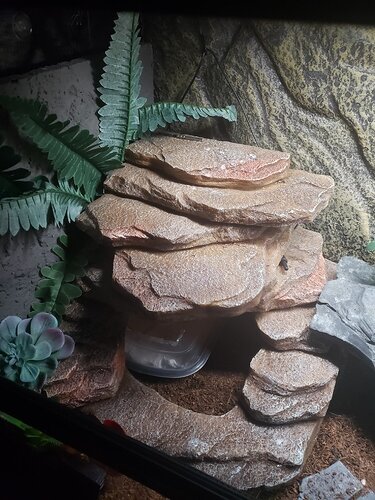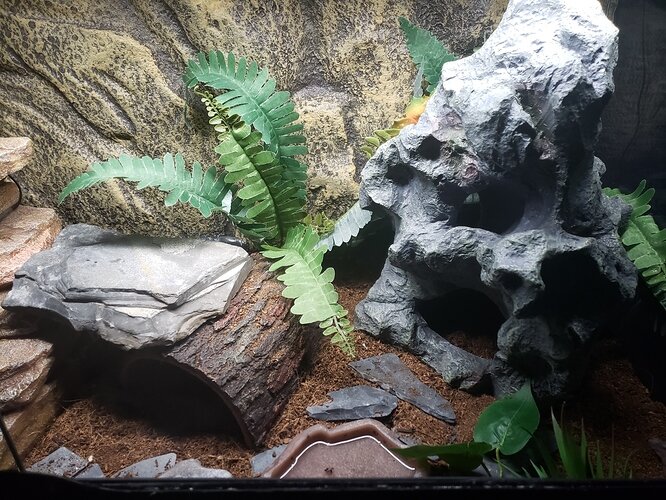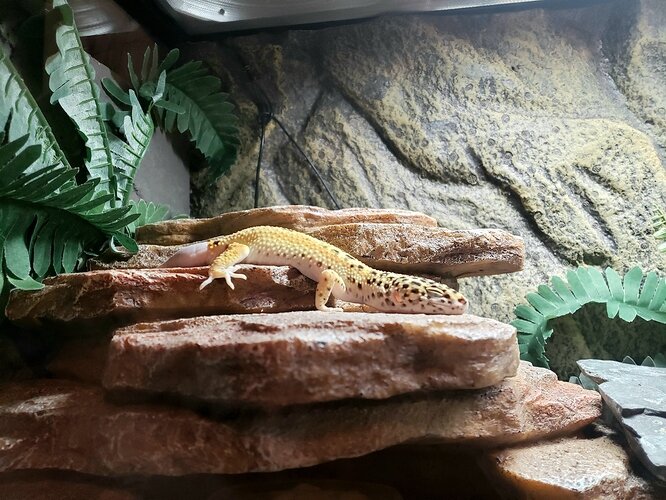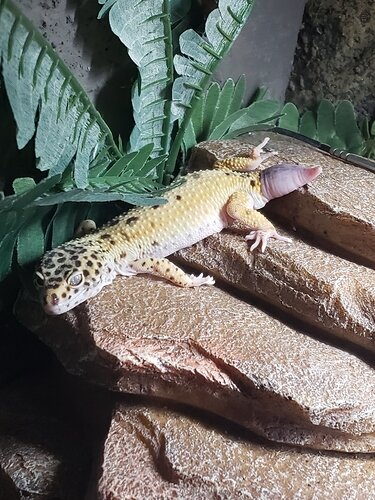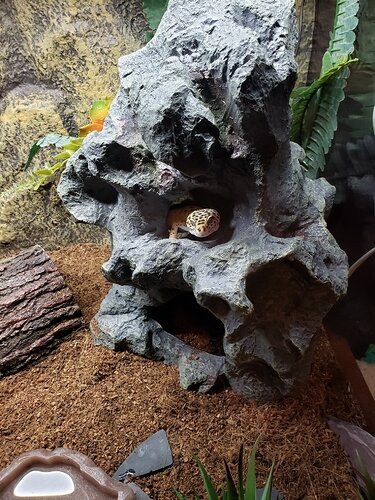I’ve had my boy about a month now, he’s 2 yrs old. When he first arrived he ate ok then got a better appetite. Sometimes he’ll refuse food for a day or two, then start right back in. I’m trying to get him on a set feeding schedule but he refuses food and throws it off. He has refused food for 4 days now. Not even remotely interested. I just cleaned out his potty corner and plenty of normal poos, but I couldn’t tell when his last one was. His temps are good and warm, no discharge from anywhere and his booty looks fine. However his tum looks a little poochy, but he did eat a big meal last time he ate 4 days ago. So maybe that’s it? I’m new to reptiles so just want to check. Should I be worried? His potty corner is clean so I’ll watch for new poos although I don’t know how often they go?? He’s been sleeping a lot too. He sleeps all day in his humid hide. Am I overthinking and worried for nothing?
He eats mealworms and super worms, gets calcium carbonate freely and repashy vitamins 2xs a week.
Are you sure your gecko is male? Female geckos sometimes refuse food sporadically during the breeding season (which is currently ongoing). The poochy tum could be that he’s ovulating. A picture of his ‘personal area’ would likely clear up the question of gender.
Definitely keep an eye out for him eliminating (pee/poo). Four days isn’t a long amount of time for a leopard gecko not to eliminate, but we need to know more context.
You did not describe your set up. This is critical to know in order to help you, as something like 95% of all pet reptile ailments are husbandry related. Some info: size/dimensions of enclosure, heat and light sources, accurate/specific temps during day and night at both hot and cold end of enclosure (take these measurements with a quality thermometer), what is inside the enclosure (substrate, dishes, huts, etc.), what is he fed, how often is he fed, and where is he fed (in bowl? loose? what do you mean he ‘throws it off?’), when did he last shed, where is the enclosure located within the house, etc., all the usual stuff.
It would also help to know where he came from, and anything you might know about how he was previously kept.
tl;dr = We need more info.
If you are new to reptiles I strongly recommend taking your new buddy in to a knowledgeable exotics vet that is familiar with reptiles.
Yes, he’s a boy. He has the distinctive pair of bumps at the base of his tail. His tail is regenerating, he lost it in shipping.
His enclosure is a 40 gal front opening terrarium, he has a dhp bulb for heat attached to a thermostat and set at 93 degrees. A few inches above the ground it’s 81, and at ground level it’s 78.5. On cold side it is 73.8. He has a led light on top that I turn off in the evening. He has a tall climbing,basking rock on the hot and a humid hide underneath. He has a cave on the cool side and he has eco earth substrate. That’s what he was on before and while it’s loose, I’ve read if ingested is easily passed bc I’d natural. But he’s tong fed so shouldn’t be an issue.
He gets free fed calcium carbonate in a little dish and repashy vitamins 2xs a week. He eats super worms and mealworms. I feed him with tongs. I feed him 5 days a week right now bc of him regenerating his tail. He’ll usually eat a mealworm or 2 and a super, and 4 days ago he ate 5 or 6 meals and 2 supers. He was really hungry lol.
What I mean by he throws off the feed schedule is that say I’m going to feed him on m,t,thurs,fri,sun with wed and sat no food, and he’ll refuse food on a day he’s supposed to eat so I have to readjust the schedule so he’s still fed 5 days a week.
I got him from a person here on MM about a month ago.
As to his last shed…he got really dusty looking about 2 weeks ago, didn’t see him she’d though. No stuck shed anywhere either.
I am going to go ahead and say to remove the eco earth. We just had someone around a week or so ago here on MM lose a leopard gecko after it ingested eco earth. Impaction/choking is a high risk because leos are small lizards and a natural substrate will not make it safer. It is safest to use reptile carpet with them, tiles are also fine. Can we also get a picture of your gecko? I don’t think an adult leo(even without a tail) needs large meals of bugs everyday. Try switching to every other day and see how he fairs.
I think he would be fine with an every other day schedule.
Beautiful enclosure, but I agree with Ashleyraeanne with regards to removing the eco earth. Instead I suggest paper towel, slate tile, or tan-colored reptile carpet-type products. Eco Earth & other similar substrates will definitely NOT get digested if swallowed (by a leopard gecko specifically). If it matters at all, I’m 100% certain of that, and i’m a vet. Leos sometimes will ingest bits of their substrate (instinctively, not consciously) if their nutritional balance is a little off, thus how the dish of calcium powder works. So, given that you are a beginner, it’s safest to use a non-particulate substrate.
I might be misreading your description- did you mean to say that it’s only in the 70s on the ground? Leopard geckos are terrestrial, and though they can and do climb a bit, they should never have to do it. You need belly heat (radiating heat from under the tank), and the hot end absolutely must be at least 85 on the ground. In a lovely 40 gallon tank like you have, honestly, I’d lift the hot end to around 91.
My probe & temp gun temps sometimes correspond to thermostat temps, thermostats can, at times, be inaccurate. For example, I set up a new 10 gallon tank recently and wasn’t paying attention when I put everything together. But then I found that the temps didn’t match. Turned out I had set something over the probe which trapped heat, and was causing the thermostat to read much higher temps than the actual surface heat, where the gecko was - so be careful with thermostat probe placement, it can really muck things up!
The cold end is too cold, in my opinion. For a beginner keeper, I’d avoid any areas in a leopard gecko tank that are below like 76 or so, even at night and with an enclosure.
I wouldn’t harp on it, but I feel the temps you described, unless I am mistaken, will probably kill him. They’re at least part of the reason he’s not eating and he’s sleeping a lot. Way before even starting in the veterinary field, I had a gecko named Stewie, she was the first hatchling I ever hatched. I wasn’t paying close enough attention to her temps, and her tank heater died. She was likely in temps comparable to what you describe, and she died. I’m hoping what I learned with a terrible loss might help you and your little dude out.
Oh, I see about the food-throwing ;). I’ve never managed to get any of my guys on any sort of schedule, so let us know if you learn any good tips! I have a male named Rasputin and he is such a pain about that! As an aside, since he is a pet you will have for his entire life, I’d suggest considering adding some feeder insects into his diet that have less chitin and have better calcium balances.
Side note: he is sooo freakin’ cute! I love the pic of him coming through the hole towards the camera!
Thanks. I worked really hard on it. Yes, on his hot side he has a deep heat projector bulb and a climbing rock that’s a few inches from it. On the top spot, it’s 92. About half way down I have a thermometer and it’s about 80. Inside the cutout on his climbing rock, I put his humid hide. It’s about 73 on the ground because it’s about 14 in from the bulb. But why would he hang out and just be cold? Wouldn’t he self regulate? If he’s cold , go to where he knows it’s warm and if he’s too hot go into his hide? I put a space heater outside his tank even with the ground level just in case to bring his temp up. He still won’t eat tonight. How long does it take to warm him up? I didn’t think eco earth would be digested, but rather passed in stool harmlessly because it’s natural. Also, I have heard debates about belly heat. I know he needs heat to digest his food, but it doesn’t have to be coming up from the ground. Rather as long as he’s getting heat he can digest fine. What insects have less chitin? And ty, he’s a cutie. I hope he’ll be ok.
Sand is natural as well and we all know it causes impaction. As stated, someone on MM lost a leo after it ingested eco earth. Any lose substrate is not safe for leos due to how small they are. If it was something like a tegu ingesting a small amount, then it would probably pass. But we are talking about a lizard that has intestines smaller than a bendy straw. There is no downside to using reptile carpet or any of the options @mblaney listed.
You need to make it so that the temps I described are the temps on the ground, where he spends his time. He doesn’t want to bask where it’s warm because he is totally exposed- there is no place for him to be both sheltered and warm, which is essential. Besides, leopard geckos are nocturnal- the heat source must not force him to come out during the day. He needs places where he is completely hidden, especially since he’s only just arrived and it’s a new home. Rule of thumb is to have 1+ hide on the hot end, 1+ hide on the cold end, and 1+ humid hide . In a 40 gal I’d just put one humid hide on each side. And I guess I should say that the required huts are all on the ground & provide perceived shelter, anything else would be more of a tank decoration or environmental enrichment. As beautiful as your tank is, it needs major changes in order to keep him alive.
I strongly recommend a switch to belly heat, especially since a 40 gallon is huge and the distance to the bottom of the tank is so great. It would be a pain, sure, but you shouldn’t have to do it more than once (unless you move). A space heater just isn’t adequate, nowhere near. You need to raise your temps or he’ll die if he eats like that. Reptiles can’t digest when their temps are too low. Any food in his GI tract will start to rot when he loses intestinal motility. That leads to anaerobic fermentation of the contents and eventually death.
The substrate thing and the temps are all really basic, so this makes me wonder where you got your info. (Can anyone else reading back me up on this? It’s really important and just my voice isn’t as strong as a consensus of peers.) If it was a book, you now know that it’s dangerously wrong. Same with a website. If you would like to know more about reliable resources for info, let us know. Here’s 2 basic ones:
Kaplan’s care sheet
A care sheet from another vet I know
Silkworms, black soldier fly larvae, (SMALL) hornworms, etc. Since you only have one gecko it’ll be a lot more economical to give him a super high quality diet. Food is hotly debated among leo hobbyists, but silkworms are agreed upon as a primo food item. Right now I feed small silkworms, very small hornworms, black soldier fly larvae, and occasionally mealworms/earthworms/superworms/and even waxies. Calcium with vit. D3 is used only sparingly (except for laying females)- I generally use calcium without d3.
Honestly, at the temps he’s been in, he may be impacted already from being so cold. My suggestion is to give him a (just barely above room temp) water soak (water about 1-2mm). It’s important that you have your temps in your tank already increased before you do this, as you can’t get him wet and then put him back in a freezing tank. The water soak may prompt him to defecate (which was the idea), so make sure you keep an eye on him and watch out for poop in the tank afterwards. If he doesn’t defecate in a day or two, and he’s still refusing food, he needs to see a reptile vet urgently.
This thread got bumped today and that’s how I found it, but @hyzinthlay, how is the little guy doing now that it’s almost a month later? Hopefully improved? 
if eco earth is bad and so is sand, which is the best substrate for leos
I personally moved to tile, you can pull it out and wipe it down. It doesn’t do much to keep smells down so you need to stay on top of it. Paper towels is a good choice. I wouldn’t recommend reptile carpet too many fibers to get thier teeth and toes caught on. I still have looser substrate areas but that’s my personal choice and I stopped using just loose eco earth. But deffinetly two of my leopards benefit from it.
I have always used paper towels for leopard geckos, and I’ve never had a problem that could be attributed to the paper towels.
I used repti carpet for my leos which worked good except the calcium got stuck in it and was impossible to get out. I recently moved all of my leos to tubs with paper towels and so far those have worked good
